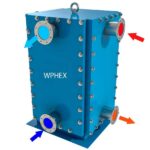This short articles describes how to find how many shells needed in series that would be sufficient to perform the duty required.
How to I know if I need more than one shell?
To answer this let’s assume the following parameters;
Th,in – Inlet Temperature of the Hot Fluid
Th,out – Outlet Temperature of the Hot Fluid
tc,in – Inlet Temperature of the Cold Fluid
tc,out – Outlet Temperature of the Cold Fluid
First check if the limitations below are approached.
2 Th,out ≥ tc,in + tc,out (if the Hot fluid on the Shell side)
2 tc,out ≤ Th,in + Th,out (if the Cold fluid on the Shell side)
If the limits are approached then you will need to use multiple shells in series
How to determine the number of shell passes?
Plot the terminal temperatures of the Hot and Cold streams on a graph paper. Your X-Axis should represent the Duty and your Y-Axis should represent the Temperature. (see figure below), Assuming the red line is linking the shell side hot terminal temperatures and the blue line is linking the tube side terminal temperatures.
Plot your terminal temperatures on the chart, then draw a horizontal lines as shown in the figure below
Starting with the cold fluid outlet temperature, a horizontal line is laid off until it intercepts the hot fluid line. From that point, a vertical line is drawn to the cold fluid temperature.
The number of shells in series is equal to the number of horizontal lines that is clearly sufficient to perform the duty. The process is repeated until a vertical line intercepts the cold fluid operating line at or below the cold fluid inlet temperature.
So the number of horizontal lines represented in the example above indicates the number of Shells required in series.
Hope this short article is helpful in identifying this issue during design of shell and tube heat exchangers.
References:
Kuppan Thulukkanam, Heat Exchanger Design Handbook, Second Edition, 2013, CRC Press
Keywords: number of shell passes, number of shells, shell passes












